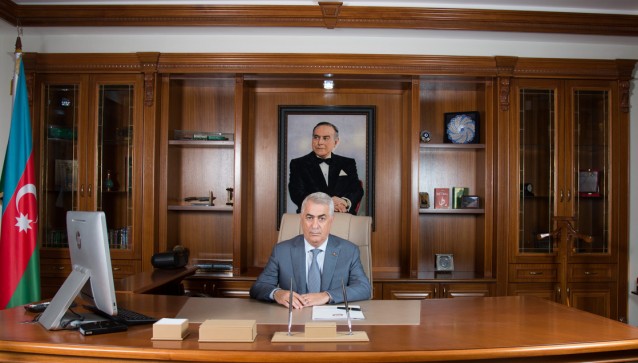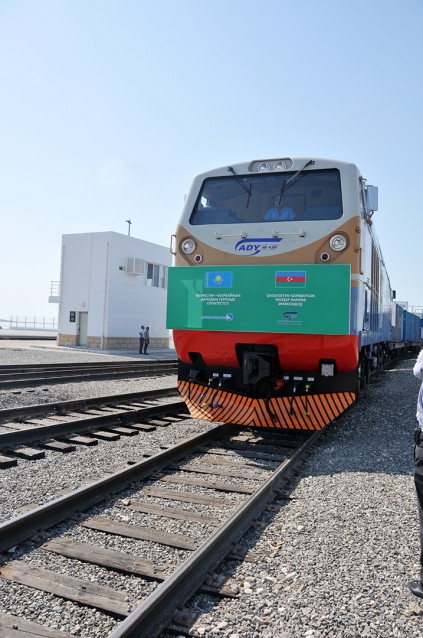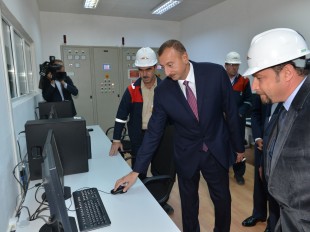In the run-up to the official launch of the Baku-Tbilisi-Kars railway on 30 October, Visions asked Javid Gurbanov, chairman of Azerbaijan Railways CJSC, for his views on this major project’s history and significance.
VoA - Javid muellim, where did the idea of the new Baku-Tbilisi-Kars transport corridor come from?
JG - Negotiations on the Baku-Tbilisi-Kars railway project were initiated at the Joint Turkey- Georgia Transport Commission meeting held in Ankara on 26-29 July 1993. A protocol on project implementation was signed by the transport ministers in Istanbul on 20-21 July 2002 and during an official visit to Georgia on 14 June 2004, Azerbaijan’s president Ilham Aliyev said that he supported the construction of a railway from Georgia to Turkey and that Azerbaijan was ready to participate in the project.
In fact an important document was also signed at the opening of the Azerbaijani section of the Baku-Tbilisi-Ceyhan oil pipeline on 25 May 2005. The presidents of Azerbaijan, Georgia and Turkey signed a Declaration on the Baku-Tbilisi-Kars railway project, which indicated the importance afforded by the state leaders to the project.
Following negotiations the signing of the agreement to begin construction took place at a trilateral meeting of presidents in the Georgian parliament on 7 February 2007. Azerbaijan provided a loan of $775 million at minimum interest to Georgia for implementation of the project.
Work on the Georgian section was launched on 21 November 2007 and the Turkey section was launched on 24 July 2008.
Some say that Baku-Tbilisi-Kars is not just a railway project, but a revival of the historical Silk Road. What is your view?
From ancient times there was a network of trade-caravan routes connecting the west and the east of Eurasia that was called the Great Silk Road. Established in the 16th century, it passed through Central Asia and connected China, the Near East and Mediterranean countries. Silk fabrics, spices, carpets, weapons, jewellery and cotton were among the goods transported along the various routes.
An important effect of the Great Silk Road was the cultural influence that passed from East to West. Caravans from the Far East passed through China, Mongolia, Central Asia and Azerbaijan to the Mediterranean and Black Sea coasts to Europe.
As countries recognised the need to strengthen economic relations, this road that had connected East and West for almost 2,000 years offered opportunities to build bridges between different cultures and civilisations with its historical significance restored.
The project that took over the Ancient Silk Road was called TRACECA (Transport Corridor Europe-Caucasus-Asia), which came about after Azerbaijan gained independence, as the new trade and economic relations with European and Asian countries resulted in changes in directions of goods transport. TRACECA’s origins were in a Conference of International Communities of Europe held in Brussels in May 1993 that involved Azerbaijan, Armenia, Georgia, Kazakhstan, Kyrgyzstan, Tajikistan, Turkmenistan and Uzbekistan. Agreement was reached on the application of a technical assistance programme financed by the European Union [to create a transport corridor between Europe and Central Asia – Ed.]
|
TRACECA is a multimodal transport network that links Europe and Asia and aims to revive the ancient Silk Road. |
An agreement between Azerbaijan, Georgia, Turkmenistan and Uzbekistan on cooperation between their railways marked a practical improvement. And in May 1996, the railways of Iran and Azerbaijan, Georgia, Turkmenistan and Uzbekistan signed up to provide mutual free transit.
An international conference held in Baku in December 1998 was dedicated to the rebirth of the ancient Silk Road. Documents adopted included a Basic Multilateral Agreement on International Transport and agreements to cooperate on railway transport. TRACECA’s Permanent Secretariat was established in Baku in 2001.
[Editor’s note: Baku-Tbilisi-Kars is an integral segment of the overall TRACECA project to revive the ancient Silk Road.]
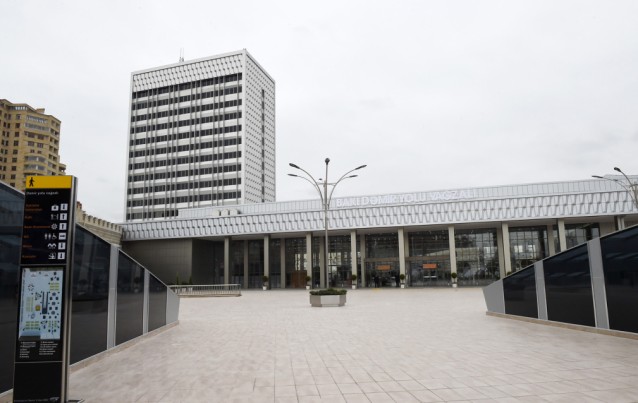 Baku Railway Station, which dates back to 1884, was reopened on 10 February this year following two years of restoration works. Photo: Azertaj
Baku Railway Station, which dates back to 1884, was reopened on 10 February this year following two years of restoration works. Photo: Azertaj
Will the Baku-Tbilisi-Kars project have an impact on the volume of export from our country?
Forecasts indicate that the line will be able to carry up to 5 million tonnes in the early years and up to 15 million tonnes in following years.
Will launching the Baku-Tbilisi-Kars railway line bring a substantial increase in the volume of transit cargoes through Azerbaijan?
Of course, it will, not only for Azerbaijan, but all participating countries. Just imagine, the Trans-Caspian international transport route, of which Azerbaijan is an active participant, serves to increase cargo transportation from China to Turkey and Europe, as well as in the opposite direction. Ukraine has since joined this route, which was established by China, Kazakhstan, Azerbaijan, Georgia and Turkey. With the launch of the Baku-Tbilisi-Kars railway it will soon be possible for container trains to run directly from China to Europe and the Mediterranean Sea.
What will be the possible volume of passenger transportation on this line?
Only after the launch of the whole project will it be possible to give ideas of passenger numbers. However, Azerbaijan has already purchased 30 passenger wagons from the Swiss Stadler Company for this route. The wagon bogies will be automatically adaptable to different line gauges, saving time at the border crossings and ensuring a comfortable ride.
[Editor’s note: It is widely reported that Baku-Tbilisi-Kars is initially expected to serve up to a million passengers per year.]
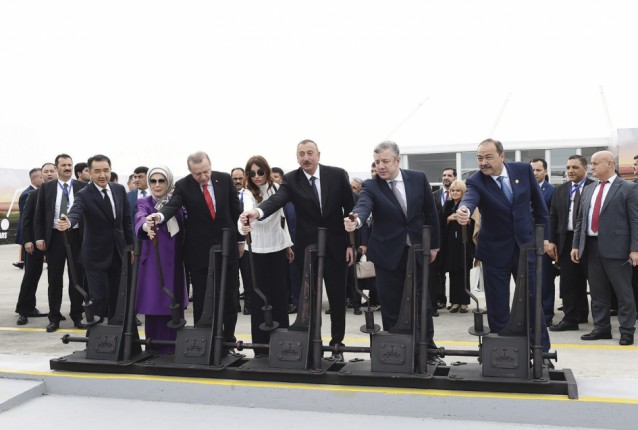 The Baku-Tbilisi-Kars railway line was launched in Alat on 30 October. Pictured here at the opening ceremony are: President of Azerbaijan Ilham Aliyev and First Lady Mehriban Aliyeva (centre); President of Turkey Recep Tayyip Erdogan with his wife Emine Erdogan (centre left); Prime Minister of Kazakhstan Bakytzhan Sagintayev (left); Prime Minister of Georgia Giorgi Kvirikashvili (centre right); and Prime Minister of Uzbekistam Abdulla Aripov (right). Photo: president.az
The Baku-Tbilisi-Kars railway line was launched in Alat on 30 October. Pictured here at the opening ceremony are: President of Azerbaijan Ilham Aliyev and First Lady Mehriban Aliyeva (centre); President of Turkey Recep Tayyip Erdogan with his wife Emine Erdogan (centre left); Prime Minister of Kazakhstan Bakytzhan Sagintayev (left); Prime Minister of Georgia Giorgi Kvirikashvili (centre right); and Prime Minister of Uzbekistam Abdulla Aripov (right). Photo: president.az
The line to the Nakhchivan Autonomous Republic has been under a rail blockade by Armenia for more than 25 years. Will the launch of this project overcome Nakhchivan’s isolation?
This process is already underway. A Nakhchivan-Tabriz-Tehran-Mashhad passenger train began operating on 29 December 2016 at the president’s express wish. Three modern passenger wagons were sent from Baku to Nakhchivan to operate a twice-weekly service planned to carry 12,000 passengers per year.
Documents are already being prepared in Iran for the construction of an Astara-Rasht line connecting the Iranian and Azerbaijani rail systems that will take two or three years. The Baku to Nakhchivan line will extend 1,450 km.
Once the North-South and Baku-Tbilisi-Kars projects are launched, Nakhchivan will be free of the blockade and be able to unleash its potential to transport its minerals, which are already in demand from Belarus.
How is work on building the necessary infrastructure progressing?
Completion of the international and regional transport corridors will have a major impact on the flow of cargo through Azerbaijan and this requires large-scale work on the railway. The 600-km Baku-Boyuk Kasik line is being renovated. Work on the new project started in late October 2015 and 360 km of railways have already been repaired. Signals, communications and electricity supplies are also being upgraded and locomotive depots modernized.
3,100 different types of freight cars have been purchased, as well as ten freight locomotives. Recently, a presentation ceremony was held in France for the first of 50 Alstom Prima M4 passenger locomotives planned for purchase by Azerbaijan Railways CJSC.
|
Baku-Tbilisi-Kars (BTK) is a railway connecting Azerbaijan, Georgia and Turkey which will serve as a key segment of the TRACECA transport network. Having been postponed several times since 2010, BTK finally launched on 30 October this year. The line is projected to triple the speed of moving goods between China and Europe and aims to bolster regional economic cooperation. |
What other countries are interested in the Baku-Tbilisi-Kars railway project besides Azerbaijan, Turkey and Georgia?
This railway also envisages the activation and development of trade and economic relations across Eurasia. Interest in joining the project comes primarily from Turkmenistan, Kazakhstan, Afghanistan, Pakistan, China and India. The construction of a railway tunnel under the Bosphorus Strait will also ensure the integration of Trans-European and Trans-Asian railway networks and the transport of goods and passengers directly to Europe and Asia through Azerbaijan, Georgia and Turkey. Once the project is launched more countries will surely make use of it.